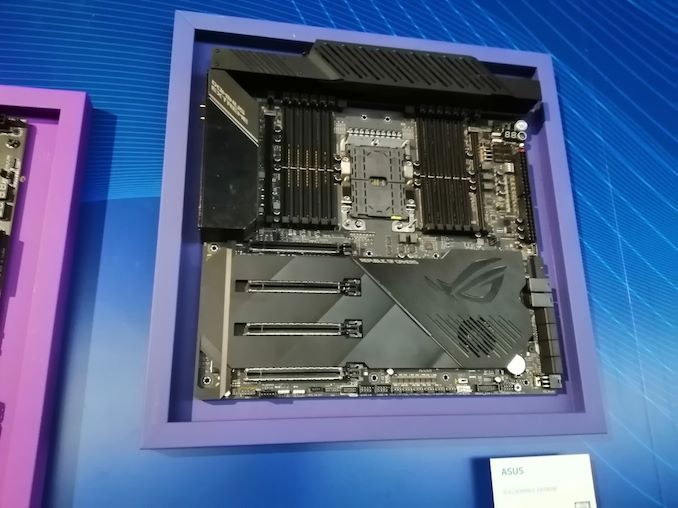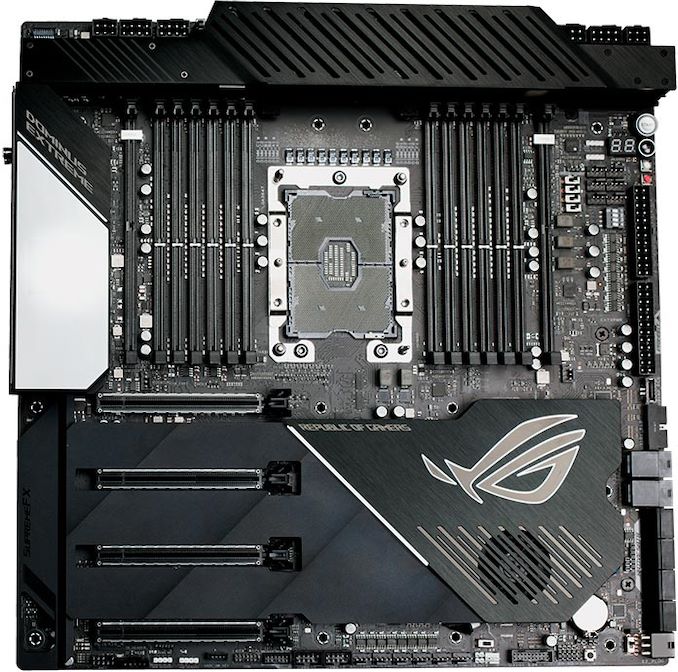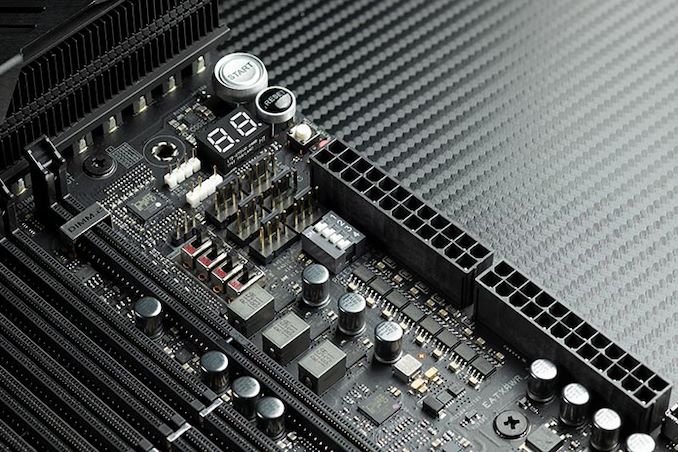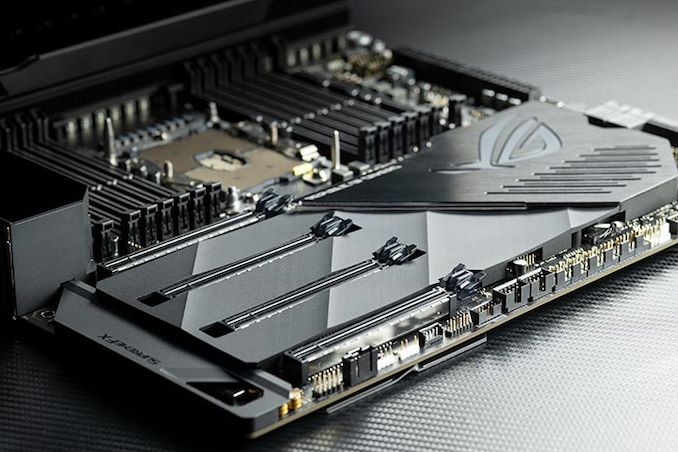ASUS Shows Off ROG Dominus Extreme Motherboard For Xeon W-3175X 28-Core CPU
by Gavin Bonshor on October 9, 2018 12:00 PM EST- Posted in
- Motherboards
- Intel
- Asus
- ROG
- Extreme
- Xeon-W
- W-3175X
- Dominus Extreme

On Monday Intel officially announced its new 28-core processor designed for extreme workstations, the Xeon W-3175X. The chip uses the company's high-end Xeon workstation/server sock, LGA3647, and as a result, new motherboards will be needed for the chip. To that end ASUS has officially announced what will be among the first boards to support the new platform, the ROG Dominus Extreme.
As we noted when we covered the new Intel Xeon W-3175X 28-core processor on Monday, the ROG Dominus Extreme is advertised as having four full-length PCIe 3.0 slots, all of which have full x16 bandwidth available. This means users looking to create a cost-is-no-object and all-out gaming system can run up to four-way SLI and four CrossFire multi-graphics cards configurations, or other crazy setups involving numerous high-bandwidth cards.
The area around the PCIe slots has a coating of armor which stretches across the majority of the bottom side of the board with a cooling fan integrated into the armor covering the chipset. The new Dominus Extreme follows the larger sized EEB (14" x 14") form factor, and ASUS has done their best to maximize the feature set to complement the ROG mission to gaming, though still following the general remit expected from a model based on an extreme workstation socket such as LGA3647.
We already know the new Intel 28-core Xeon W-3175X has a massive TDP of 265 W, and the ROG Dominus Extreme is designed to cope with this and more with a clear focus on overclocking performance for the new chip. Providing power to the board is a pair of 24-pin ATX 12 V motherboard power connectors, with a further four 8-pin and two 6-pin 12 V ATX CPU power inputs which suggests that when overclocked, the Xeon W-3175X is going to draw a lot more than 265 W.
The ASUS ROG Dominus Extreme will feature a plethora of features to satisfy gamers and power users, with support for up to 512 GB of ECC or non-ECC system memory across twelve RAM slots, and we already know the new Intel Xeon W-3175X features a six-channel memory controller. The memory slots are complemented by what ASUS calls their ROG DIMM.2 slot, a series of M.2 riser cards which offer room for up to four M.2 slots. Also featured is a pair of U.2 ports. The power delivery is advertised as having a 32-phase design with four hidden fans which are controlled thermally, meaning they will only spin up when the situation requires it.
An 'overclockers toolkit' located in the top right corner. In this toolkit of sorts are PCIe lane switches which allow users to enable or disable individual full-length PCIe 3.0 slots, a pair of dedicated power and reset buttons, as well as an LED debug for diagnostic purposes. As expected with a workstation-level motherboard, ASUS has included a total of twelve 4-pin fan headers throughout the PCB, with six of these located in the top right-hand corner of the board. Sitting next to these are various monitoring headers for use in temperatures flow monitoring for water cooling, as well as leak detection on compatible and supported CPU blocks.
Visual features include a 1.77" LiveDash OLED, which is designed to give the board a more premium feel. Full ASUS AURA Sync RGB support is also present, which is featured on the majority of the ROG based models. Featured on the rear panel is an Aquantia AQC107 10 G LAN port along with an Intel AC-9260 802.11ac Wi-FI adapter capable of achieving 1.73 Gbps. For the gamers a Realtek based SupremeFX S1220 HD audio codec offers up to 8-channels, and we know the Dominus Extreme will have USB 3.1 Gen2 Type-A and Type-C ports implemented into the mix.
The pricing and availability of the ASUS ROG Dominus Extreme is currently unknown at present, although there are rumours the board will be released in December, with more information expected in the coming month.
Related Reading:
- Intel Announces Xeon W-3175X: 28-Core Processor for Extreme Workstations
- Intel's New Core and Xeon W-3175X Processors: Spectre and Meltdown Security Update
- Intel to Hold PC Desktop Event on Monday, October 8th
- Intel Fall PC Desktop Event Live Blog (Starts at 10am ET/14:00 UTC)
- Intel Z390 Motherboard Overview: 50+ Motherboards Analyzed
- Intel Announces 9th Gen Core CPUs: Core i9-9900K (8-core), i7-9700K & i5-9600K
Source: ASUS



















26 Comments
View All Comments
Hxx - Wednesday, October 10, 2018 - link
yeah the box needs to be tricked out too. I wont accept a plain cardboard box. Something like a transparent hexagon made of Tempered Glass with ROG engraved in the front...at the very least.PeachNCream - Tuesday, October 9, 2018 - link
Armor1: defensive covering for the body especially : covering (as of metal) used in combat
2: a quality or circumstance that affords protection the armor of prosperity
3: a protective outer layer (as of a ship, a plant or animal, or a cable)
4: armored forces and vehicles (such as tanks)
Notably absent from Merriam-Webster is any mention of the motherboard plastic panel equivalent of a toy doll's accessory purse that adds style and makes adult boys feel a little more like real men.
Flunk - Tuesday, October 9, 2018 - link
I think, calling in what it is, a dust cover, didn't look good in the promotional material.DanNeely - Tuesday, October 9, 2018 - link
"6-pin 12 V ATX CPU power inputs"When did a 6 pin 12v CPU power option get added to the ATX spec? Way back in the early days of ATX - pre 4pin 12v connector - when systems mostly ran on the 3.3/5V rails there was a 6 pin connector to provide those legacy voltages - but AFAIK the 12V CPU connector has always only been 4 or 8 pins. Is this a new connector (in which case, why not just go with 3x8 pin ones from each PSU instead), or is ASUS connecting a pair of 6 pin GPU power connectors to the mobo for extra power? I've occasionally seen the latter done on the bottom half of boards intended to support 3/4 way SLI/xFire.
Chaitanya - Tuesday, October 9, 2018 - link
Those are 6 pin Pci-e connectors not CPU connectors and looking and power config(2x24 pin) that 28core cpu is going to be a power hog.Chaitanya - Tuesday, October 9, 2018 - link
Also there are bent pins in the photos sent to press so I guess shoddy build quality should also be added to feature list of this motherboard.jcc5169 - Tuesday, October 9, 2018 - link
The article says the systems supports 128gb of memory. If the system supports 16gb dimms, would the total not be 192gb instead of 128gb (12x16gb=192gb)Ian Cutress - Tuesday, October 9, 2018 - link
Intel said the chip supports up to 512GB memory. I've updated the articleDevo2007 - Tuesday, October 9, 2018 - link
That is a weird amount across 12 DIMM slots.DanNeely - Wednesday, October 10, 2018 - link
The bounding factor is presumably some data structure or hardware interface being power of 2 bound. eg number of bits available to store the address in a bitpacked data structure (where the remaining high bits are used to store metadata), or the number of physical address bit lines in hardware.